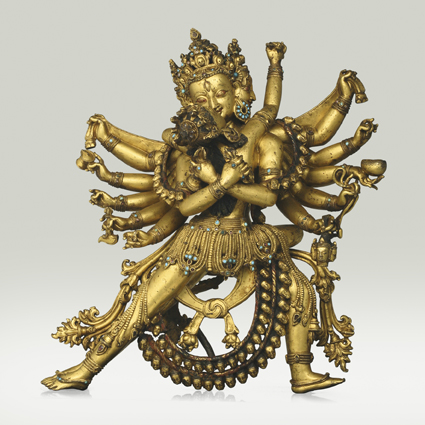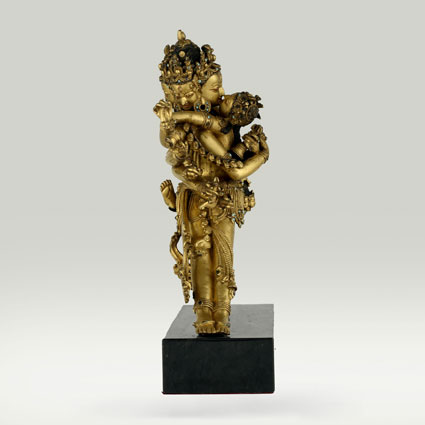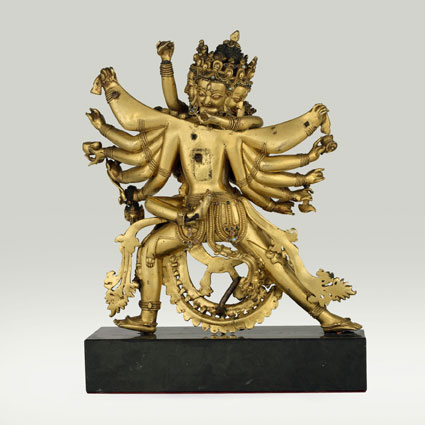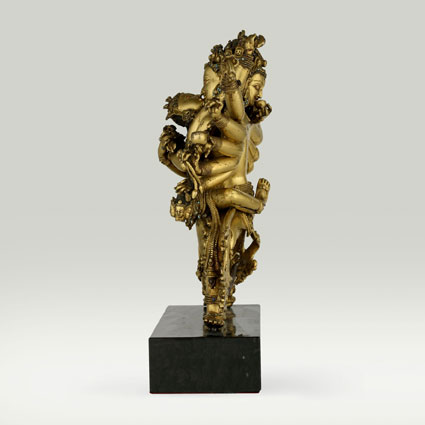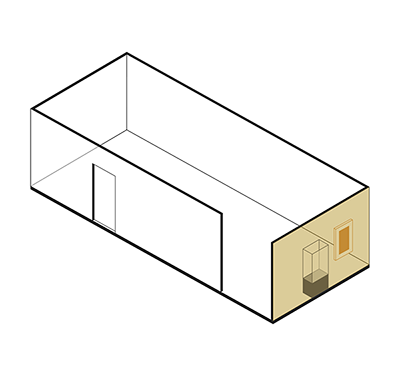ABS 187
Code: ABS 187
Country: Tibet
Style: Nepalese School
Date: 1500 - 1600
Dimensions in cm WxHxD: 24.8 x 28.5 x 10
Materials: Gilt copper; inset with turquoise
This tantric sculptures is almost certainly the product of a Newar artists working for Tibetan patrons. The Newar succeeded in matching Tibetan taste to such an extent that such artworks must be labelled Tibetan. The “Tibetan gilt copper traditions” are entirely determined by Tibetan patronage and not by the origin of the artist.
Heruka is a collective name for fierce manifestations of the Thatagatas. These images are identified in this publication either as forms of Hevajra (Tib. Kyai rdo rje), Buddhakapala (Tib. Sangs rgyas lo sdom pa), Mahamaya (Tib. sGyu 'phrul chen po), Samvara (Tib. bDe mchog), Cakrasamvara (Tib. 'Khor lo sdom pa), or Vajradaka (Tib. rDo rje mkha' 'gro). The Sandhanamala (SM) and Nispannayogavali (NSP) contains sadanas of several variations of Cakrasamvara, Mahamaya, samvara, and Vajradaka under various names: with one face and two arms named Samvara (tib. bDe mchong) (SM 255; CBI 565, 578, 978, 2276 (73); with three faces and six arms named Vajradhaka (Tib. rDo rje mkha' 'gro), Heruka (Tib. He ru ka) (SM 250), or Samvara (SM 251), with four faces and four arms named Mahamaya (NSP 9. SM 248), Heruka, Hevajra (SM 239), or Vajradaka (SM 249); with four faces and twelve arms named Sri Cakrasamvara (Tib. dPal 'kor lo sdom pa) or Cakrasamvara (NSP 12; CBI 3, 977, 1048, 2266 (63).
(From Wikipedia, the free encyclopedia)
Cakrasaṃvara Tibetan: Korlo Demchog (Wylie: khor lo sdom pa / bde mchog) is the principal yidam, or meditational deity, and herukaof the Kagyu sect of Tibetan Buddhism. The Cakrasamvara sadhana is considered to be of the mother class of the Anuttara Yoga Tantra. Cakrasamvara is typically depicted with a blue-coloured body, four faces, and twelve arms, and embracing his consort Vajravarahi in the yab-yumposition. Other forms of the deity are also known, with varying numbers of limbs. Cakrasamvara and consort are not to be thought of as two different entities, as an ordinary husband and wife are two different people; in reality, their divine embrace is a metaphor for the union of great bliss and emptiness, which are one and the same essence.
Vajrayogini or Vajravarahi
Vajrayogini or Vajravarahi (Tibetan: Dorje Naljorma, English: the Vajra yogini; also Tibetan: Dorje Phagmo, Wylie: rdo-rje phag-mo, English: the Vajra Sow) is a dakini, a tantric Buddhist ishta-deva(Tib. yidam). Her sadhana(practice) originated in India between the 10th and 12th century. It evolved from the Chakrasamvara sadhana, where Vajrayogini appears as his yab-yumconsort, to become a stand-alone practice in its own right.
Vajrayogini is often associated with triumph over ignorance as well as with abandonment (one of her hidden aspects is Varuni, Hindu goddess of alcohol and intoxication). Vajrayogini is key to the advanced sadhanaof Chöd. Vajrayogini is visualized as the translucent, deep red form of a 16 years old female with the third eye of wisdom set vertically on her forehead. Iconographically, Vajrayogini, like most of the Dakini, is often signified with the investiture of Digambar. She is often pictured with a sow and is an important deity for tantric initiation, especially for new initiates - Vajrayogini's practice is said to be well-suited to those with strong desirous attachment, and to those living in the current "degenerate age". Her consort is Chakrasamvara, who is often depicted as a spear on Vajrayogini's shoulder. The seven-headed form of Vajrayogini is similar to the Hindu goddess Chinnamasta. Vajrayogini is the yidamthat a meditator identifies with when practicing Six yogas of Naropa
In Tibet the abbess of Samding monastery, on the shores of the Yamdrok Tso Lake near Gyantse, was traditionally a tulkuof Dorje Phagmo. The current incarnation resides in Lhasa.
Béguin, Gilles, 2013. Art sacré du Tibet – Collection Alain Bordier, [catalogue of the exhibition held at the Fondation Pierre Bergé – Yves Saint Laurent; 14 mars au 21 juillet 2013]. Paris: Fondation Pierre Bergé – Yves Saint Laurent. Editions Findakli.
Bhattacharyya, Benoytosh , 1958. Indian Buddhist Iconography. Calcutta: K. L. Mukhopadhyay. Pp. 159-165 - References to Cakrasamvara, Mahamaya, Samvara, and Vajradaka
Bock, Etienne; Falcombello, Jean-Marc; Jenny Magali, 2022. Trésors du Tibet. Sur les pas de Milarépa.. Paris: Flammarion. p. 102
Chandra, Lokesh, 1991. Buddhist Iconography of Tibet (CBIT). New Delhi: International Academy of Indian Culture & Aditya Prakashan. Nos. 3, 32, 40, 269, 564-65, 578, 736-37, 976-79, 967, 996, 1048, 1366f, 2266(63), 2270 (67), 2276 (73) - References to Cakrasamvara, Mahamaya, Samvara, and Vajradaka
Cornu, Philippe , 2001. Dictionnaire Encyclopédique du Bouddhisme. Seuil.
de Mallmann, Marie-Thérèse, 1975. Introduction à l'iconographie du tântrisme bouddhique. Paris: Adrien Mainsonneuve (Jean Maisonneuve successeur (1970). Pp. 186-190 - References to Cakrasamvara, Mahamaya, Samvara, and Vajradaka
Huntington, Susan L. and John C., 1990. Leaves from the Bodhi Tree: The Art of Påla India (8th–12th centuries) and Its International Legacy, [catalogue of the exhibition held at the Dayton Art Institute, Dayton, Ohio]. Seattle & London: University of Washington Press. Pp. 535-540 - References to Cakrasamvara, Mahamaya, Samvara, and Vajradaka
Linrothe, Rob, 1999. Ruthless Compassion: Wrathful Deities in Early Indo-Tibetan Esoteric Buddhist Art. . London: Serindia Publ.. Pp. 276-94, figs. 198-216 - References to Cakrasamvara, Mahamaya, Samvara, and Vajradaka
Midal, Fabrice, 2000. Mythes et dieux tibétains. Une entrée dans le monde sacré.. Edition du Seuil.
Mitra, Mallar, 1998. "An Image of twelve-Armed Sambara in the Russeh (Russek) Collection, Switzerland", Facets of Indian Culture. Patna: Bihar Puravid Parishad. Pp. 321-25, 1 fig - References to Cakrasamvara, Mahamaya, Samvara, and Vajradaka
Sèngué, Tcheuky, 2002. Petite Encyclopédie des Divinités et symboles du Bouddhisme Tibétain. Editions Claire Lumiere . Pp. 204-209 - Références françaises : Chakrasamvara
Sèngué, Tcheuky, 2002. Petite Encyclopédie des Divinités et symboles du Bouddhisme Tibétain. Editions Claire Lumiere . Pp. 262-266 - Références françaises: Vajravarahi
von Schroeder, Ulrich, 2010. Buddhist Sculptures of the Alain Bordier Foundation. Hong Kong: Visual Dharma Publications, Ltd.. Pp. 36–37; plate 15A
von Schroeder, Ulrich, 2013. Datenbank der Fondation Alain Bordier. Unpublished.

